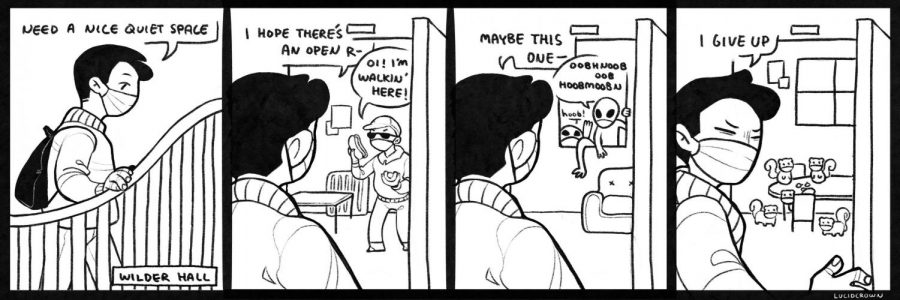Oberlin Desperately Needs More COVID-Safe Study Spaces
As the weather got colder this year, one clear flaw in Oberlin’s COVID-19 safety plan began to emerge: the shortage of socially-distant study spaces on campus. While libraries and Wilder Hall provide some options, the libraries’ limited hours mean that Wilder is far too crowded. With midterms on the horizon, simply waiting for warmer weather to improve this problem would be too little, too late. Oberlin needs to open up more indoor study spaces with more flexible hours to combat student burn-out.
It is difficult and unreasonable to ask students to work exclusively in their rooms. For many on-campus students, their bedroom is the only place they can rest, eat, take their remote classes, and so much more. How can they be expected to focus on independent work in that kind of environment? More than hindering students’ ability to work, forcing them to study near their beds can be detrimental; many studies show that working in the same place you sleep contributes to increased anxiety and insomnia.
While Wilder Hall’s booths and rooms offer some respite from this problem, by no means do they present a perfect solution. The building is crowded and loud, already keeping it from being an ideal study spot. More than that, the presence of DeCafé and the Rathskeller combined with the cold weather make Wilder a prime spot for students who want to eat indoors. The private rooms are in incredibly high demand –– you can see the throngs of students shuffling aimlessly through the halls, looking for anywhere to sit. The Student Union building has become synonymous with the seemingly endless rigmarole of knocking on closed doors and praying for no response. If you can’t get a classroom spot, there is no place to sit in the building’s halls without being exposed to students with their masks off and eating. Even if being near unmasked students were not a concern, it can be hard to get a hallway table at all during peak hours. And none of this takes into account students who need a reliably quiet place to concentrate.
The art library and the science library are both great COVID-safe quiet study options, but their hours are extremely limited. Both the art and science libraries offer indoor study space, but through the hours of 9:30–4:30 p.m. most weekdays. As an employee of the Clarence Ward Art Library, I understand why the hours are business hours rather than more student friendly because of the schedules of the library’s professional staff — but as a student, those hours don’t make sense for me to do independent work. Many college students are booked with classes and jobs during the daytime, and at nighttime are left with no place to work safely and consistently during their peak studying hours.
I am currently working on an Honors thesis, and I can feel how the lack of on-campus study space has negatively affected my ability to work. So much of my writing process relies on my having a physical space that helps me focus. Even small details, like no longer having an Honors student’s typical access to a private Scholar Study, have wide-reaching ramifications on my productivity, mental health, and physical health. Not having reliable access to a place to keep my books on campus means I have to physically carry whatever I want to use to study from my off-campus house to campus, because while I know I can’t work in my house I also know that I can’t keep my books in my art library study carrel if I want to use them outside of the library’s limited hours. Those books are heavy, and the strain of carrying all of my materials back and forth not only disincentivizes me from working, it can also be physically painful –– my back literally hurts from carrying the weight of my own nomadic study requirements.
I understand the COVID-19 concerns with opening up more indoor space on campus for students, but the status quo is neither productive nor safe. Study space on this campus does exist — it’s just all in one place, or at inconsistent hours. The concentration of students in Wilder Hall makes for a less safe environment than we’d have if Scholar Studies or study spaces within Mudd Center were also open. Mudd is even already staffed at many of the all-important evening study hours. I do not see why it would be impossible, or even difficult, to make available more spots to quietly study in Mudd. There is the already extant LibCal system that the other libraries use, which students could use to book specific tables within Mudd; this would expand on Mudd’s existing policy on booking study rooms, of which only four are currently available. Mudd could even be set up like Wilder, with elective study spots. Regardless of how, opening up Mudd would present a quieter, safer alternative to Wilder, with less food and more supervision.
We need more late-night physical options for studying so that the whole campus isn’t packed into one building, and so that students like me have an actual shot at focusing. Wilder is overwhelmed and overwhelming, teeming with hordes of anxious students looking for a safe place to sit or study. As the weather gets warmer, and people can eat and spend time outside again, this problem will lessen but many of us will still need a quiet place to work indoors. Oberlin’s dearth of consistent indoor study spaces with student-friendly hours has made this already difficult year even harder than it needed to be – but we still have time to fix it.







